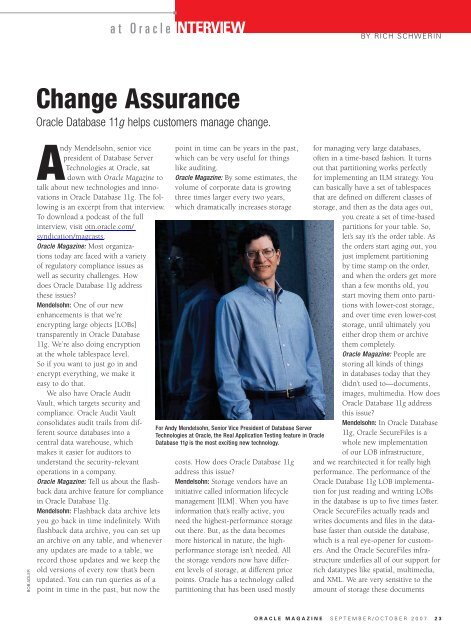Oracle Magazine - September/October 2007 - Marcelo Machado
Oracle Magazine - September/October 2007 - Marcelo Machado
Oracle Magazine - September/October 2007 - Marcelo Machado
You also want an ePaper? Increase the reach of your titles
YUMPU automatically turns print PDFs into web optimized ePapers that Google loves.
BOB ADLER<br />
at <strong>Oracle</strong>INTERVIEW<br />
Change Assurance<br />
<strong>Oracle</strong> Database 11g helps customers manage change.<br />
ndy Mendelsohn, senior vice<br />
president of Database Server<br />
Technologies at <strong>Oracle</strong>, sat<br />
down with <strong>Oracle</strong> <strong>Magazine</strong> to<br />
talk about new technologies and innovations<br />
in <strong>Oracle</strong> Database 11g. The following<br />
is an excerpt from that interview.<br />
To download a podcast of the full<br />
interview, visit otn.oracle.com/<br />
syndication/magcasts.<br />
<strong>Oracle</strong> <strong>Magazine</strong>: Most organizations<br />
today are faced with a variety<br />
of regulatory compliance issues as<br />
well as security challenges. How<br />
does <strong>Oracle</strong> Database 11g address<br />
these issues?<br />
Mendelsohn: One of our new<br />
enhancements is that we’re<br />
encrypting large objects [LOBs]<br />
transparently in <strong>Oracle</strong> Database<br />
11g. We’re also doing encryption<br />
at the whole tablespace level.<br />
So if you want to just go in and<br />
encrypt everything, we make it<br />
easy to do that.<br />
We also have <strong>Oracle</strong> Audit<br />
Vault, which targets security and<br />
compliance. <strong>Oracle</strong> Audit Vault<br />
consolidates audit trails from different<br />
source databases into a<br />
central data warehouse, which<br />
makes it easier for auditors to<br />
understand the security-relevant<br />
operations in a company.<br />
<strong>Oracle</strong> <strong>Magazine</strong>: Tell us about the flashback<br />
data archive feature for compliance<br />
in <strong>Oracle</strong> Database 11g.<br />
Mendelsohn: Flashback data archive lets<br />
you go back in time indefinitely. With<br />
flashback data archive, you can set up<br />
an archive on any table, and whenever<br />
any updates are made to a table, we<br />
record those updates and we keep the<br />
old versions of every row that’s been<br />
updated. You can run queries as of a<br />
point in time in the past, but now the<br />
point in time can be years in the past,<br />
which can be very useful for things<br />
like auditing.<br />
<strong>Oracle</strong> <strong>Magazine</strong>: By some estimates, the<br />
volume of corporate data is growing<br />
three times larger every two years,<br />
which dramatically increases storage<br />
For Andy Mendelsohn, Senior Vice President of Database Server<br />
Technologies at <strong>Oracle</strong>, the Real Application Testing feature in <strong>Oracle</strong><br />
Database 11g is the most exciting new technology.<br />
costs. How does <strong>Oracle</strong> Database 11g<br />
address this issue?<br />
Mendelsohn: Storage vendors have an<br />
initiative called information lifecycle<br />
management [ILM]. When you have<br />
information that’s really active, you<br />
need the highest-performance storage<br />
out there. But, as the data becomes<br />
more historical in nature, the highperformance<br />
storage isn’t needed. All<br />
the storage vendors now have different<br />
levels of storage, at different price<br />
points. <strong>Oracle</strong> has a technology called<br />
partitioning that has been used mostly<br />
BY RICH SCHWERIN<br />
for managing very large databases,<br />
often in a time-based fashion. It turns<br />
out that partitioning works perfectly<br />
for implementing an ILM strategy. You<br />
can basically have a set of tablespaces<br />
that are defined on different classes of<br />
storage, and then as the data ages out,<br />
you create a set of time-based<br />
partitions for your table. So,<br />
let’s say it’s the order table. As<br />
the orders start aging out, you<br />
just implement partitioning<br />
by time stamp on the order,<br />
and when the orders get more<br />
than a few months old, you<br />
start moving them onto partitions<br />
with lower-cost storage,<br />
and over time even lower-cost<br />
storage, until ultimately you<br />
either drop them or archive<br />
them completely.<br />
<strong>Oracle</strong> <strong>Magazine</strong>: People are<br />
storing all kinds of things<br />
in databases today that they<br />
didn’t used to—documents,<br />
images, multimedia. How does<br />
<strong>Oracle</strong> Database 11g address<br />
this issue?<br />
Mendelsohn: In <strong>Oracle</strong> Database<br />
11g, <strong>Oracle</strong> SecureFiles is a<br />
whole new implementation<br />
of our LOB infrastructure,<br />
and we rearchitected it for really high<br />
performance. The performance of the<br />
<strong>Oracle</strong> Database 11g LOB implementation<br />
for just reading and writing LOBs<br />
in the database is up to five times faster.<br />
<strong>Oracle</strong> SecureFiles actually reads and<br />
writes documents and files in the database<br />
faster than outside the database,<br />
which is a real eye-opener for customers.<br />
And the <strong>Oracle</strong> SecureFiles infrastructure<br />
underlies all of our support for<br />
rich datatypes like spatial, multimedia,<br />
and XML. We are very sensitive to the<br />
amount of storage these documents<br />
ORACLE MAGAZINE SEPTEMBER/OCTOBER <strong>2007</strong> 23


